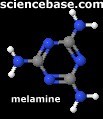Spliced feed for The Science Network |
| Melamine in Milk [Sciencebase Science Blog] Posted: 17 Sep 2008 02:14 AM CDT
Manufacturer, Sanlu, part-owned by New Zealand’s Fonterra Cooperative, recalled all of its powdered milk products in China’s north-west province of Gansu. However, twenty-two brands, including China Mengniu Diary Co and Inner Mongolia Yili Industrial Group, of milk powder have so far been identified as containing melamine. “The majority of afflicted infants ingested Sanlu-brand milk powder over a long period of time, their clinical symptoms showed up three to six months after ingesting the problematic products,” Health Minister Chen Zhu told Bloomberg Asia. Allegedly, the manufacturer(s) involved in the scandal add toxic melamine to the formula to artificially inflate the reading for protein levels. Formula milk was not until now tested for melamine, because regulators never before suspected that manufacturers would adulterate their products with such a compound. So, what is melamine and how does it spoof the protein levels in baby formula milk?
Indeed, it is this high nitrogen level - 66% nitrogen by mass - in melamine that gives it the analytical characteristics of protein molecules. Melamine can also be described as a trimer of cyanamide, three cyanamide units joined in a ring. It is a rather harmful compound, according to its MSDS sheet: “Harmful if swallowed, inhaled or absorbed through the skin. Chronic exposure may cause cancer or reproductive damage. Eye, skin and respiratory irritant.” Not something you would want in your infant’s milk. Previously, melamine was found in exported pet food last year and blamed for killing thousands of cats and dogs in the US. Bloomberg also reports that analysis of samples of ice cream produced by Yili have also revealed the presence of melamine. Regardless of crushing inflation and legislative pressure, there is no excuse for the adulteration of food in this way. Diluting a product, the previous approach by the manufacturers, is highly unethical and can lead to malnutrition, but straight poisoning is infanticide. |
| You are subscribed to email updates from The Science Network To stop receiving these emails, you may unsubscribe now. | Email Delivery powered by FeedBurner |
| Inbox too full? | |
| If you prefer to unsubscribe via postal mail, write to: The Science Network, c/o FeedBurner, 20 W Kinzie, 9th Floor, Chicago IL USA 60610 | |
 Today, we learn that several thousand babies in China are seriously ill, having suffered acute kidney failure, with several fatalities, among those given formula milk contaminated with the industrial chemical melamine. The toll is far higher than was previously admitted by the Chinese authorities, according to the
Today, we learn that several thousand babies in China are seriously ill, having suffered acute kidney failure, with several fatalities, among those given formula milk contaminated with the industrial chemical melamine. The toll is far higher than was previously admitted by the Chinese authorities, according to the 
No comments:
Post a Comment